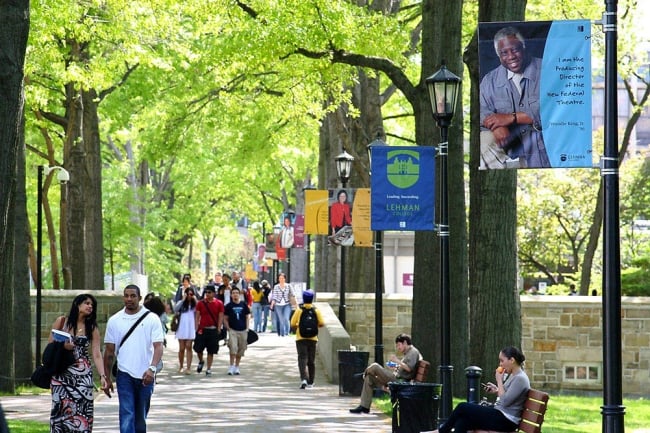You have /5 articles left.
Sign up for a free account or log in.

Institutions such as CUNY Lehman College in the Bronx, N.Y., were graded much higher for economic mobility of their graduates when the social and financial backgrounds of their students are factored in.
CUNY Lehman College
California State University, Los Angeles serves 24,223 undergraduates, 69.8 percent of them Hispanic and 68 percent of whom are from low-income families or backgrounds.
The university used funds available through the CSU system’s Graduation Initiative 2025, which was launched in 2015, to start a student success program that offers free or reduced tuition and course fees, expanded academic advising and counseling, mental health assistance, and financial help for emergency expenses, including for food and housing. The university also created a California Promise program, with college completion incentives, such as as early registration privileges for key courses and access to advanced academic advising, for first-year students who pledge to graduate in four years.
The institution’s six-year graduation rate rose from 36 percent for first-year students entering in 2007 to 52.1 percent for those entering in 2015, the most recent figures available. The four-year graduation rate for students entering in 2007 jumped from 6.8 percent to 21.1 percent in 2017.
University administrators' targeted efforts to improve student performance, increase academic outcomes and help students graduate and prosper postgraduation landed the university at the very top of a list of the 10 institutions that provided students with the most economic mobility, according to a new index that used different metrics to rank colleges and universities based on how well they serve low-income students.
“If you’re a policy maker, if you’re a decision maker, if you’re trying to get the biggest bang for your buck, this is where you want to invest your resources,’’ said José Gómez, provost and vice president of Cal State L.A.
The authors of a report released earlier this year sought to measure those very factors and designed the new Economic Mobility Index, which looked at low-income students and ranked the colleges and universities that provided them the most economic mobility based on the number of such students the institutions enrolled and the return on investment, or ROI, they provided for students. The top 10 of those colleges were Hispanic-serving institutions, or HSIs, in California, New York and Texas—states with large Hispanic populations—according to the report by Third Way, a public policy think tank.
Economic mobility has long been considered a good measurement of the postgraduation financial status of students. The economic outcomes for graduates of Ivy League and other selective top-tier private and public universities are unsurprising; those students tend to do well even if they’re first-generation college students or from low-income backgrounds. But what about the great majority of students, many of them Hispanic or Black, who attend midrange or nonselective institutions and also end up better off after graduation but whose in-college and postgraduation experiences don’t fall under the traditional metrics used to measure economic mobility? The report asked and answered those very questions using the new index.
Deborah Santiago, CEO of Excelencia in Education, an organization that advocates for Latino student success, said the findings outlined in the report reflected what students from low-income backgrounds needed and got from colleges to succeed academically, and how they made out once they complete/ed college.
She noted that the report looked at “inclusive data, instead of exclusive data,” which she says is the usual lens through which economic mobility is usually framed. (“Above and beyond enrollment, what do those exclusive universities do to actually serve those students?” she asked.) More importantly, the report closely evaluated what the HSIs did to serve students, Santiago said.
“Students who get into the Harvards and Yales are going to do well anyway, because the hardest part was getting in, because they are so selective,” she said. The Third Way report shines a light on the institutions serving a different mission and the need for a different definition of economic mobility, and different metrics for gauging it, such as whether the less prestigious colleges have strong affordability and financial support systems in place and are intentional about addressing the unique needs of first-generation and low-income students.
The universities to which she referred ranked highest in price-to-earnings premium, using U.S. government data on 1,320 institutions to determine how long it takes for students from lower-income backgrounds to recoup their education costs when they begin working after college. The metric is based on the salary for the average student who earned an undergraduate degree, compared to that of a student who graduated high school but did not earn a college degree. The numbers reflected well on universities with selective admissions and prestigious reputations that put graduates in position to earn high salaries soon after joining the workforce.
But when Third Way’s index also included data on the percentage of lower-income students enrolled at each institution who received federal Pell Grants, the rankings changed dramatically, elevating institutions with open admissions, lower costs, more financial support and less resulting loan debt for students.
Historically Black colleges and universities also performed better under Third Way’s index.
“Beyond the overemphasis on institutional selectivity, other factors such as racial, economic, and educational discriminatory practices have also systemically undervalued the accomplishments of HBCUs across the US,” the report said. “However, when accounting for the proportion of low- and moderate-income students that colleges enroll and the outcomes those schools produce, HBCUs score much higher on the [Economic Mobility Index] than traditional rankings reflect.”
Colleges that typically perform well on traditional rankings—such as Duke and Stanford Universities—also provide high returns on investment for low-income students because they enroll a relatively small number of high-achieving low-income students. But after factoring in the number of Pell Grant–eligible students enrolled at each institution, Duke fell from the top spot to No. 722. Stanford dropped from second to No. 548.
Courtney Brown, vice president of impact and planning at the Lumina Foundation, called the new index “the type of information the field and individuals need.”
For the institutions that scored high in the index, she said, success “isn’t about who they don’t admit and only taking in the cream of the crop. These institutions instead provide opportunities to more low-income, first-generation and students of color who have been denied opportunities to excel, and they then work hard to ensure success for them.”
Brown praised the institutions on the list for their efforts and said that potential students and their families need to know more about the services the institutions provide.
“It’s essential that we provide data and information to individuals about their investments and how likely an institution is to be a good match for them, serves people that are like them well and provides economic mobility,” she said. “If people, especially those who are low or moderate income, decide to invest in learning after high school, they should have access to this information to make an informed decision.”
Jeff Gold, interim associate vice chancellor of student success for the CSU system, said the Graduation Initiative 2025 reflects the commitment the entire system has made to give the most students possible the opportunity for social mobility.
“We have a sense of purpose that permeates the faculty, the staff, the administration and all the departments and services on every campus,” Gold said. “It’s interwoven into the system’s DNA.”
The CSU system provides $700 million in annual financial aid grants to students to help raise retention and graduation rates, Gold said. The graduation initiative is also intended to close racial, income and generational equity gaps in those areas, he added. (Note:This sentence was revised to reflect that the $700 million went directly to students as grants and not to the individual campuses in the CSU system.)
According to CSU data for the 2020–21 academic year, 82 percent of the system’s students receive some form of financial aid, 59 percent receive enough aid to fully cover tuition and students’ average loan debt of $18,173 is $10,777 less than the national average. The system has also frozen tuition for the 2022–23 academic year.
Gold said the system is also prioritizing making it easier for students who have left college to return by simplifying the application process and making it free to apply.
Gómez, the provost at Cal State L.A., said traditional measurements of economic mobility, such as enrollment and graduation rates, should be updated to provide more information.
“You can measure graduation rates, and when you measure it without context, it’s kind of meaningless,” he said. “But when you measure it with context, when you look at how you bring in all the other populations, low income, underrepresented, it changes how you evaluate your performance.”
Serving the community in which the institutions are located are important factors as well, Gómez said, noting that 80 percent of the university’s alumni live in Los Angeles County. Similarly, at CUNY Lehman College, also in the Economic Mobility Index’s top 10, 60 percent of its students are from the Bronx, where the college is located, and more than half of its alumni live in New York City or New York State.
“We see the demand from in the community, and we see the pressure points from within the community,” said Fernando Delgado, president of Lehman, where 47 percent of the 10,500 undergraduate students are first generation, 83 percent are Black or Hispanic, and 89 percent are Pell eligible.
Delgado who spoke at recent panel discussion about the report, said Lehman increased its offerings in nursing and health-related courses to meet local and regional labor market needs and partnered with area businesses to provide more internships and work-study opportunities. He said university officials are also exploring building on-campus housing for students to address shortages in affordable housing.
The CUNY system—two of its 25 institutions were in the top 10 of the Economic Mobility Index, and 10 were in the top 50—emphasizes its affordability, roughly $7,500 in annual tuition and fees. It also partners with several city and regional employers and agencies, including the New York City mayor’s office, to offer students internships, work-study jobs, job training programs and networking opportunities.
Nicole Siegel, deputy director of education at Third Way, noted a shift in thinking and reporting on economic mobility since the new index was released.
“We’ve seen kind of a sea change. Media publications are starting to see student outcomes differently,” she said. Public attention on and policy debates about student loan debt, rising college costs and the effect of federal and state funding on the financial choices students make have shifted the conversation, she said.
Siegel noted that while Harvard is worthy of praise for the strong return on investment for its lower-income students, there were only 1,150 Pell Grant recipients in its 9,950-student population in this index, compared to the number of such student enrolled at Cal State L.A.
“It’s important to celebrate those institutions that are delivering the most to the students that need it the most,” she said.
Siegel said Third Way plans to continue to draw more attention in the coming months to the performance of other minority-serving institutions, such as HBCUs, and to update the evaluations.
“We’re continuing to build on the data and thinking as the data grows,” Siegel said.
Gómez said not only would students be better served as a result, policy makers would also be better informed.
“When people try to decide where to put public investment and where will you have the greatest impact on economic and educational equity, you’ll want to put it in places that have results for elevating and creating ladders of opportunity,” he said.




